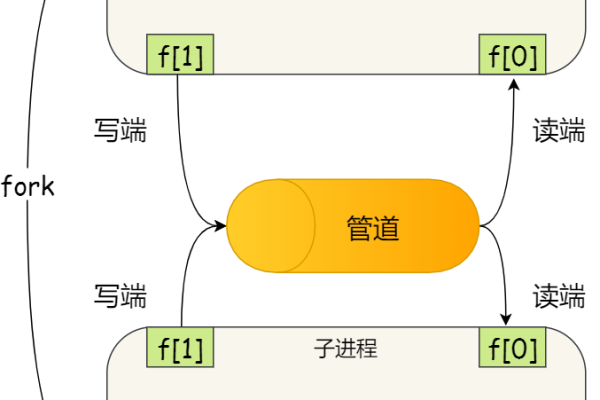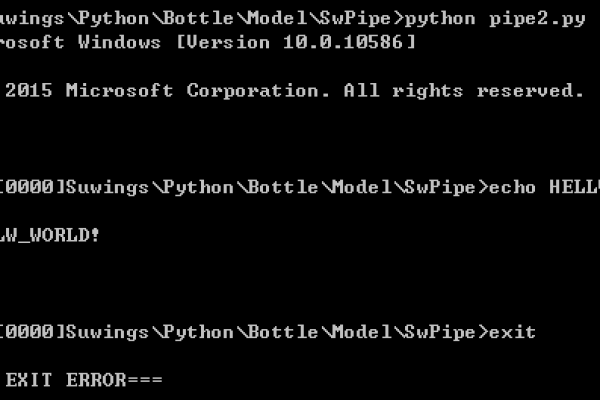C中如何创建Pipe通信?操作步骤及注意事项?
- 行业动态
- 2025-03-03
- 2
csharp,using System;,using System.IO;,using System.IO.Pipes;,using System.Text;class Program,{, static void Main(), {, const string pipeName = "testpipe"; using (var server = new NamedPipeServerStream(pipeName, PipeDirection.InOut)), {, Console.WriteLine("Waiting for client connection...");, server.WaitForConnection();, Console.WriteLine("Client connected."); using (var reader = new StreamReader(server)), using (var writer = new StreamWriter(server) { AutoFlush = true }), {, string temp;, while ((temp = reader.ReadLine()) != null), {, if (temp == "exit"), break;, writer.WriteLine($"Echo: {temp}");, }, }, }, },},“这段代码创建了一个命名管道服务器,等待客户端连接并回显收到的消息。
在C#中创建管道通信,可以通过命名管道(Named Pipes)来实现,命名管道是一种简单的进程间通信(IPC)机制,允许不同进程之间进行数据交换,以下是使用C#创建命名管道通信的详细步骤和示例代码:
创建命名管道服务器端
1、创建命名管道:使用NamedPipeServerStream类来创建命名管道。
2、等待客户端连接:通过调用WaitForConnection方法等待客户端连接。
3、读取和写入数据:使用Read和Write方法与客户端进行数据交换。
4、关闭连接:通信完成后,关闭管道连接。

示例代码
using System;
using System.IO;
using System.IO.Pipes;
using System.Text;
class NamedPipeServer
{
static void Main()
{
// 定义管道名称
string pipeName = "MyNamedPipe";
// 创建命名管道配置
PipeSecurity pipeSecurity = new PipeSecurity();
pipeSecurity.AddAccessRule(new PipeAccessRule(WindowsIdentity.GetCurrent(), PipeAccessRights.ReadWrite, System.Security.AccessControl.AccessControlType.Allow));
// 创建并启动命名管道服务器
using (NamedPipeServerStream pipeServer = new NamedPipeServerStream(pipeName, PipeDirection.InOut, 1, PipeTransmissionMode.Message, PipeOptions.Asynchronous, 512, 512, pipeSecurity))
{
Console.WriteLine("等待客户端连接...");
pipeServer.WaitForConnection();
Console.WriteLine("客户端已连接!");
// 读取客户端发送的数据
byte[] buffer = new byte[512];
int bytesRead = pipeServer.Read(buffer);
string message = Encoding.UTF8.GetString(buffer, 0, bytesRead);
Console.WriteLine("收到消息: " + message);
// 向客户端发送响应
string response = "消息已收到";
byte[] responseBytes = Encoding.UTF8.GetBytes(response);
pipeServer.Write(responseBytes);
// 关闭管道连接
pipeServer.Close();
}
}
} 创建命名管道客户端
1、连接到命名管道:使用NamedPipeClientStream类连接到服务器端的命名管道。
2、发送和接收数据:通过Write和Read方法与服务器端进行数据交换。
3、关闭连接:通信完成后,关闭管道连接。
示例代码
using System;
using System.IO;
using System.IO.Pipes;
using System.Text;
class NamedPipeClient
{
static void Main()
{
// 定义管道名称
string pipeName = "MyNamedPipe";
// 连接到命名管道服务器
using (NamedPipeClientStream pipeClient = new NamedPipeClientStream(".", pipeName, PipeDirection.InOut))
{
Console.WriteLine("正在连接到命名管道服务器...");
pipeClient.Connect();
Console.WriteLine("已连接到命名管道服务器!");
// 向服务器发送数据
string message = "你好,服务器!";
byte[] messageBytes = Encoding.UTF8.GetBytes(message);
pipeClient.Write(messageBytes);
// 读取服务器的响应
byte[] buffer = new byte[512];
int bytesRead = pipeClient.Read(buffer);
string response = Encoding.UTF8.GetString(buffer, 0, bytesRead);
Console.WriteLine("收到响应: " + response);
// 关闭管道连接
pipeClient.Close();
}
}
} 注意事项
确保服务器端先运行并创建命名管道,否则客户端将无法连接。

管道名称在服务器端和客户端必须一致。
根据需要调整缓冲区大小和其他参数。
处理异常情况,如管道连接失败、读写错误等。
FAQs
Q1: 如果多个客户端同时尝试连接到同一个命名管道服务器,会发生什么?

A1:NamedPipeServerStream的构造函数中有一个参数表示可以同时连接的最大客户端数量(上例中为1),如果多个客户端同时尝试连接,而该参数设置的值小于客户端数量,那么多余的客户端将无法立即连接,直到有可用的连接槽位,可以通过调整此参数来支持更多并发客户端连接。
Q2: 如何在命名管道通信中使用异步操作?
A2: 在上述示例中,NamedPipeServerStream的构造函数中使用了PipeOptions.Asynchronous选项来启用异步操作,对于异步读取和写入,可以使用BeginRead、EndRead、BeginWrite和EndWrite方法,或者使用await关键字配合Task对象(如果使用.NET 4.5及更高版本),这样可以提高应用程序的响应性和性能,特别是在处理大量数据或高并发场景下。







